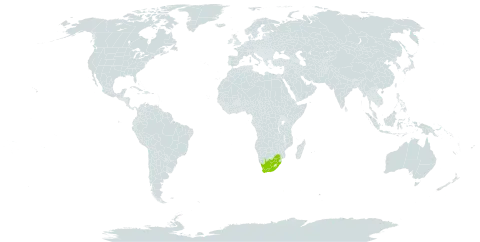Dwarf shrub, ('bisexual'), ('female') or occasionally ('bisexual') + ('female'), ('bisexual') + ('male') or ('male), many-stemmed, often rounded to ± cylindrical, sometimes slightly fetid. Stems (80-)150-400(-450) mm long, sparsely to ± much branched, branches ascending to ± spreading, not densely leafy. Leaves decussate; blades (3-)5-15(-18) x (0.6-)0.8-2(-2.5) mm, linear(-lanceolate), ascending to erect, ericoid, often shallowly concave above or semiterete in section, scabrid at least on margins; stipular sheath cup-shaped. Flowers solitary or paired, ± sessile to shortly pedicellate, fruiting pedicels sometimes elongating to c. 7 mm; calyx 5(-6)-merous, lobes (2.5-)4-6 mm long, linear-lanceolate, subequal, spreading to ± erect; corolla 5(-6)-merous, yellowish green, often with reddish brown or brownish purple streaks. ('bisexual'), ('male'): tube 1.5-2.5 mm long, lobes 2.5-4 x 1-2 mm; anthers 2-2.5(-3) mm long; ('bisexual'): gynoecium as in ('female'); ('male'): small rudimentary ovary and stigmas present. ('female'): tube 0.3-0.6 mm long, lobes 0.5-1.2 x 0.4-0.5 mm; stigmas 2, (4-)5-9 mm long; ovary c. 1.5-2.0 mm long. Fruit green, turning grey-brown, c. 2-3 x (2.5-)3.0-3.5 mm, ± turbinate to subglobose, 2-seeded; diaspore c. 1.5-2.5 x 1.0-1.5 mm, greyish white to dark grey, ± elliptical to obovate in dorsal view, dorsal side convex, ventral side plane to slightly concave, ± rugose and ribbed.
